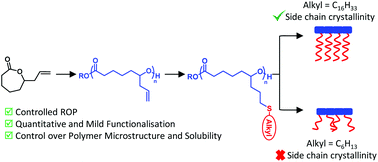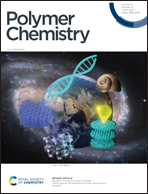Controlling the crystallinity and solubility of functional PCL with efficient post-polymerisation modification†
Abstract
Poly(ε-caprolactone) is a semi-crystalline biocompatible polymer with good mechanical properties. Its crystallinity also uniquely enables poly(ε-caprolactone) to be used in different applications, from the development of 3D scaffolds for tissue engineering to advanced nanoparticle design. However, the lack of side-chain functionality in the polymer backbone prevents further functionalisation, thereby limiting the potential to alter physico-chemical properties. Herein, we report the well-controlled ring-opening polymerisation (ROP) of ε-allyl caprolactone using Mg(BHT)2(THF)2 to furnish an allyl-functionalised PCL suitable for post-polymerisation modification. The isolated polymer could then be quantitatively post-functionalised via the efficient thiol–ene addition using a variety of commercially available alkyl thiols. The effect of alkyl chain length on bulk polymer properties was investigated, and demonstrates the potential to tune solubility and crystallinity of poly(ε-caprolactone) in a simple and efficient fashion. Lipophilic, functional polyesters that possess crystallinity are rare but this feature is crucial to exploit further applications of biocompatible polyesters such as for drug delivery or as a robust scaffold for tissue engineering.



 Please wait while we load your content...
Please wait while we load your content...